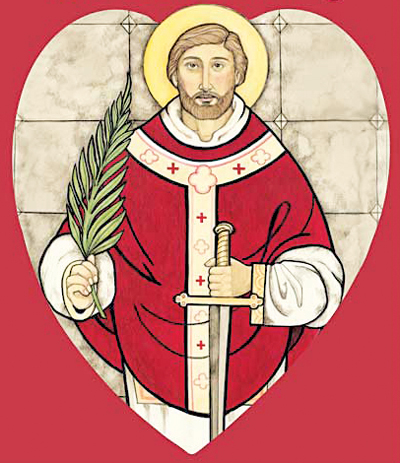THE ‘UNOFFICIAL SAINT’

Most of us know our Nation observes the birthdays of Presidents George Washington (Feb. 22) and Abraham Lincoln (Feb. 12) this month on President’s Day (Feb. 20).
Some folks commemorate Groundhog Day (Feb. 2) and Flag Day (Feb. 24). We’re also familiar with Valentine’s Day (Feb. 14) with many celebrating the “unofficial saint” by sending cards, decorating the house and holding parties. You may ask, “Why is St. Valentine designated as an ‘unofficial saint?’” Here’s a quick multiple-choice quiz that may reveal the answer.
St. Valentine was:
– A priest in the Roman Empire who helped persecuted Christians during the reign of Claudius II, who was thrown in jail and later beheaded on Feb. 14
– A Catholic bishop of Terni who was beheaded, also during the reign of Claudius II.
– Someone who secretly married couples when marriage was forbidden, or suffered in Africa, or wrote letters to his jailer’s daughter and probably was beheaded
– All, some or possibly none of the above
If you guessed D., give yourself a box of chocolates. Although the mid-February holiday celebrating love and lovers remains wildly popular, the confusion over its origins led the Catholic Church, in 1969, to drop St. Valentine’s Day from the Roman calendar of official, world-wide Catholic feast days because so little is known about him. However, the Church still recognizes him as a saint, listing him in the Feb. 14 spot of Roman Martyrolgy.
Each year on Feb. 14 we peruse the store shelves for the perfect gift or card for a loved one. According to Hallmark, more than 163 million cards — not including packaged kids’ valentines —are exchanged. And it’s not just an American phenomenon. Valentine’s Day is celebrated in Canada, Mexico, the United Kingdom, France, Australia, Italy and Denmark. But why? How did this holiday of love and romance originate and, more importantly, how did St. Valentine become involved? The legends attributed to the mysterious saint are as inconsistent as the actual identification of the man.
The answers to those questions are not easy ones. According to Americancatholic.org, the roots of St. Valentine’s Day lie in the ancient Roman festival of Lupercalia, which was celebrated on Feb. 15. For 800 years the Romans had dedicated this day to the god Lupercus. On Lupercalia, a young man would draw the name of a young woman in a lottery and then would keep the woman as a companion for the year.
Pope Gelasius I was, understandably, less than thrilled with this custom. So, he changed the lottery to have both young men and women draw the names of saints whom they then would emulate for the year (a change that no doubt disappointed a few young men). Instead of Lupercus, the patron of the feast became Valentine. Whoever he was, Valentine did really exist, because archaeologists have unearthed a Roman catacomb and an ancient church dedicated to St. Valentine. In 496 AD Pope Gelasius marked Feb. 14 as a celebration in honor of his martyrdom.
For Roman men, the new day continued to be an occasion to seek the affections of women, and it became a tradition to give out handwritten messages of admiration that included Valentine’s name. Afterall, who would want to wish a woman you admired, “Happy Lupercalia Day?”
Also, there was a conventional belief in Europe during the Middle Ages that birds chose their partners in the middle of February. Therefore, the day was dedicated to love, and people observed it by writing love letters and sending small gifts to their beloved.
Legend has it that Charles, duke of Orleans, sent the first real Valentine card to his wife in 1415, when he was imprisoned in the Tower of London.
If you need more occasions to celebrate in February, or during any month, for that matter, you can find lists on line of plenty of unusual holidays. For example, in February, they include but are by no means limited to: Feed the Birds Day (Feb. 3), National Pizza Day (Feb. 9) and Drink Wine Day (Feb. 18). Cheers!
- April Is The 4th Month Of The Year… We Think - April 12, 2024
- ‘Time Will Tell’ - March 1, 2024
- ‘I Cannot Tell A Lie’ - February 16, 2024


